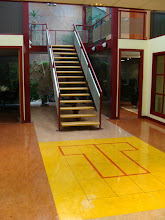
Las intervenciones de Scarpa sobre edificios ya existentes podrían incluirse dentro de un supuesto (por inexistente) movimiento teórico que podríamos denominar “restauración creativa”, que permitiría transformar sutil y sensiblemente lo preexistente para volver a introducirlo en el debate arquitectónico moderno. Algo que por otro lado ya habían hecho, en otras circunstancias teóricas, grandes arquitectos del pasado (Brunelleschi, Alberti, Bramante, Palladio o Borromini).
Scarpa’s restorations on existing buildings could be included in the supposed theoretical movement that could be called “creative restoration.” The changes that Scarpa made, although subtle, would transform and re-introduce the buildings into the contemporary architectural scene. Something that great architects of the past had only done in theory (Brunelleschi, Alberti, Bramante, Palladio or Borromini).
Si revisamos la restauración del ala de habitaciones de la antigua fortaleza de Verona para convertirla en sede del denominado “Museo di Castelvecchio” observamos un desinterés evidente por seguir una determinada teoría de la restauración (arqueológica, estilística o científica) y un posicionamiento claro a favor de mostrar la evolución constructiva (incluso histórica) del monumento, haciendo visible para el visitante la biografía del edificio, a través de la exposición ordenada de las diferentes épocas que lo hicieron posible.
If we review the renovation of the bedroom wing of the Verona Castle, which was converted into the “Museo di Castelveccio”, we can detect a clear disregard for following a particular restoration theory (archeological, stylistic, or scientific). Furthermore, it can be observed a clear position in favor of demonstrating the evolution and development of the building (including historical); making it discernible to the public the biographical history of the structure, through the display of the different fractions of the building which were blatantly constructed in different eras.
En una conferencia en Madrid pronunciada por Scarpa en el año 1978, el arquitecto confiesa que “A Castelvecchio tutto era falso. Ho deciso di adottare alcuni valori ascendenti, per romperé la innaturale simmetria: lo richiedeva il gotico e il gotico, soprattuto quello veneziano, non è molto simmetrico”.
At a conference in Madrid held by Scarpa in 1978, the architect confessed that “A Castelvecchio tutto era falso. Ho deciso di adottare alcuni valori ascendenti, per romperé la innaturale simmetria: lo richiedeva il gotico e il gotico, soprattuto quello veneziano, non è molto simmetrico”.
En efecto, el edificio sobre el que Scarpa inicia su trabajo, más allá de mostrar su origen romano y sus posteriores avatares constructivos se había convertido en un falso “Palazzo” medieval fruto de una supuesta restauración historicista de 1923.
In fact, the building in which Scarpa began his work, more than just displaying his Roman origins and his subsequent constructed avatars, was converted into a false “palazzo,” which was the medieval result of an alleged historical restoration in 1923.
Ante tal tergiversación del edificio histórico, Scarpa demuele por completo un fragmento de la fachada para descubrir las diversas capas ocultas del edificio y lo convierte (colocando la escultura de Cantagrande della Scala) en santo y seña de la intervención, en claro enfrentamiento con quienes se postulan a favor de una supuesta “unidad de estilo” que evita, aún hoy, “mostrar las cicatrices del tiempo” en clara contraposición al hecho de evidente de que es el “tiempo”, como diría Goya, “quién también pinta”.
As a result of the alteration of this historical building, Scarpa completely destroyed a portion of the façade which lead to the discovery of the various hidden layers and converted (placing the sculpture Cantagrande della Scala) the purpose of the intervention. Moreover, in clear conflict with those who are in favor of a supposed “unity of style” that conceals the “displaying of the scars of time,” which is in stark contrast to the obvious fact that it is “time,” according to Goya, “who also paints.”
Luis Cercós (LC-Architects)
http://www.lc-architects.com/






























































































